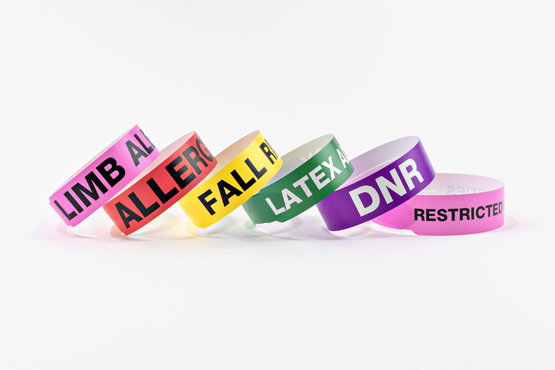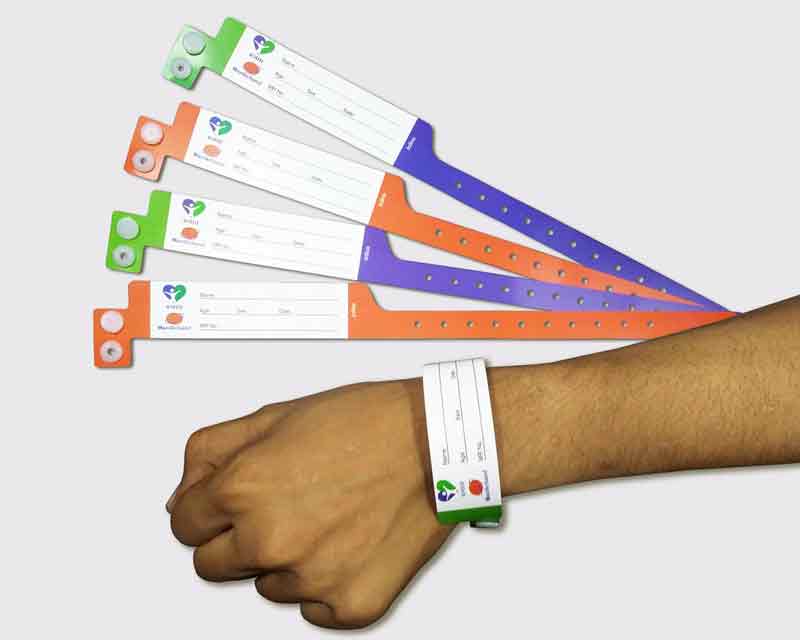Exploring the Various Kinds Of Patient Identification Band Made Use Of in Medical Facilities
In the intricate world of medical care, the essential role of Patient Identification bands frequently goes undetected. These bands, varying from easy paper wristbands to advanced RFID bands, create the foundation of Patient safety methods, making certain precision in Patient Identification. Yet, the large variety of these bands, each with its special benefits and constraints, is commonly overlooked. As we navigate through this subject, one may get insight right into the subtle intricacies and vital significance of such bands in medical centers.
Understanding the Value of Patient Identification Bands
While they may seem like mere devices, Patient Identification bands play a crucial duty in medical facilities. These bands serve as a crucial tool for confirming Patient identification, stopping medical errors connected to misidentification. Patient Identification bands likewise aid in streamlining administrative tasks, guaranteeing exact record-keeping and billing.
Typical Paper Wristbands: Their Usage and Limitations
Typical paper wristbands have actually been a staple in Patient Identification throughout various clinical centers. While their use prevails, they harbor certain constraints that might impact their performance in Patient monitoring. This section will certainly concentrate on the extent of their application and the intrinsic drawbacks related to their use.
Paper Wristbands: Use Scope
In the world of Patient Identification, paper wristbands have actually long held a crucial function. These bands are generally made use of in outpatient settings, where the Patient's stay is short-lived. The wristbands consist of important details such as the Patient's name, day of birth, and a special Identification number. This straightforward, yet efficient system, permits medical specialists to swiftly and properly determine people, guaranteeing the proper treatment is administered. Paper wristbands are also utilized in emergency situation situations, where fast Identification is critical. Their usage includes occasions like blood contribution drives and mass vaccination programs, better highlighting their versatility. Regardless of developments in modern technology, the humble paper wristband stays a cost-efficient and dependable option for Patient Identification in numerous healthcare circumstances.
Limitations of Paper Wristbands
In spite of their extensive usage, paper wristbands are not without their downsides. In enhancement, paper wristbands frequently lack the technological capabilities of even more modern alternatives, such as barcoding or RFID chips, limiting their capability to just showing written info. Paper wristbands can create discomfort or skin irritability to some clients, especially when put on for prolonged durations.
Barcoded Wristbands: Innovations in Patient Identification
While Patient Identification has long been a vital aspect of medical care, the development of barcoded wristbands represents a significant jump ahead. These bands leverage the simpleness of barcoding innovation, enabling for Patient information to be promptly checked and accessed. They improve the speed and precision of Patient Identification, decreasing the threat of clinical errors related to misidentification. Barcoded wristbands are cost-effective, very easy to create, and get rid of handwriting errors usual with manual systems. Nevertheless, they are not without limitations. While they supply improvements over typical bands, the barcode can end up being used or smudged, rendering it unreadable. Regardless of this, barcoded wristbands continue to be a necessary tool in contemporary medical care settings, representing the junction of technology and Patient care.
Superhigh Frequency Identification (RFID) Bands: an Action In The Direction Of Futuristic Health Care
The development of Patient Identification bands has actually caused the development of Radio Frequency Identification (RFID) Bands (patient dig this identification band). These cutting-edge gadgets present essential advantages for medical care centers, using a much more efficient and highly progressed ways of Patient Identification. The application of RFID in healthcare is a significant action towards an extra advanced approach to Patient monitoring and safety and security
Recognizing RFID Bands

RFID Bands: Key Benefits
Embracing a future where technology and healthcare merge, superhigh frequency Identification bands offer numerous vital benefits. Mostly, these bands boost Patient safety and security by supplying precise, instant Identification, thus decreasing medical mistakes. RFID bands can save a substantial quantity of Patient data, consisting of case history and allergies, making it possible for customized care. They additionally enhance administrative jobs, as the automated information entry changes manual procedures, enhancing efficiency and lowering documents. RFID bands supply real-time tracking visit here of people, vital in risky atmospheres such as surgical procedure or intensive treatment. These bands are resilient and immune to environmental aspects, ensuring constant capability. In general, RFID bands stand for a substantial development in Patient Identification modern technology, benefiting both clients and medical care companies.
Carrying Out RFID in Medical Care
These bands offer a smooth way to track and recognize clients, guaranteeing their safety and enhancing efficiency in treatment procedures. RFID bands lower medical mistakes by providing precise Patient Identification, which is vital in avoiding misdiagnosis or incorrect medication management. Hence, the application of RFID bands is a substantial step in the direction of boosting Patient security and medical care shipment.

Color-Coded Wristbands: Aiding in Quick and Accurate Medical Diagnosis
In the bustling atmosphere of a clinical center, color-coded wristbands have emerged as crucial devices for swift and accurate Identification of a client's clinical problem. These wristbands, put on by clients, bring details shades that correspond to different medical conditions or conditions. This useful link system is made to offer immediate visual hints to health care companies, boosting Patient safety and care quality.
Techniques for Efficient Execution and Monitoring of Patient ID Bands
Accomplishing optimal usage of Patient Identification bands demands a well-structured technique for their execution and monitoring. Patient education is additionally critical; patients have to comprehend the function of the bands and the requirement for their constant wear. It's necessary to have a backup plan in area, such as barcode scanning or biometrics, to make sure that Patient Identification is never endangered.
Conclusion
Patient Identification bands are important in clinical centers to ensure safety and accuracy. Efficient application and administration of these bands can dramatically lower medical errors, boost efficiency, and enhance total Patient treatment.
These bands, differing from simple paper wristbands to advanced RFID bands, form the backbone of Patient safety and security methods, ensuring precision in Patient Identification.The advancement of Patient Identification bands has brought about the development of Radio Frequency Identification (RFID) Bands. Overall, RFID bands stand for a substantial innovation in Patient Identification innovation, benefiting both patients and healthcare service providers.
RFID bands reduce medical mistakes by giving precise Patient Identification, which is crucial in preventing misdiagnosis or incorrect medicine management. Patient education is also critical; people have to recognize the objective of the bands and the requirement for their constant wear.